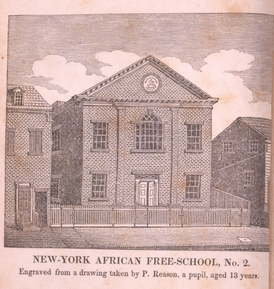African Free School
Soon after the Revolution, in 1785, a group of wealthy, powerful white men formed the New York Manumission Society. Although many were slave owners, their mission was to aid the enslaved, and to gradually end slavery in the state. As part of their efforts, they opened the African Free School in 1788, where the children of both free and enslaved blacks were taught reading, writing, arithmetic, and geography. The boys also studied astronomy, a skill needed by seamen, and the girls learned sewing and knitting. The school had many visitors—especially on examination days when students could show off their work to outsiders. In this way, they could prove to doubting New Yorkers that black students were "not inferior to those of fairer complexions…in acquiring a knowledge of Letters."
The school began with about 40 students in one room. In the 1820s, as the date of freedom for New York’s slaves drew near, the enrollment grew to 800 students. By 1834, when the African Free schools were absorbed into the New York public school system, over 1,400 students were enrolled in seven school buildings.
Many of the students of the African Free School went on to become community leaders. James McCune Smith became the first African American licensed doctor, Henry Highland Garnett was a leading abolitionist and the first African American to address Congress, and Ira Aldridge became the most famous African American actor of his day. As students, these men learned the art of public speaking. As adults, many used that skill to speak out for freedom, justice, and equality for their race.
This entry contributed by
Curriculum Concepts International
Related Media
Images

|
African Free School #2 was located at 135-137 Mulberry Street in the neighborhood then known as Five Points. All together, there were at least seven African Free Schools in the city.
|

|
This photo of Rev. Henry Highland Garnet was published in 1887.
|

|
This picture of African Free School #2 is based on a drawing by one of its students named Patrick Reason. He, like many of his fellow students, went on to become a leading abolitionist.
|

|
This portrait of Rev. Henry Highland Garnet is from a black and white photo first published in the late 1880s.
|

